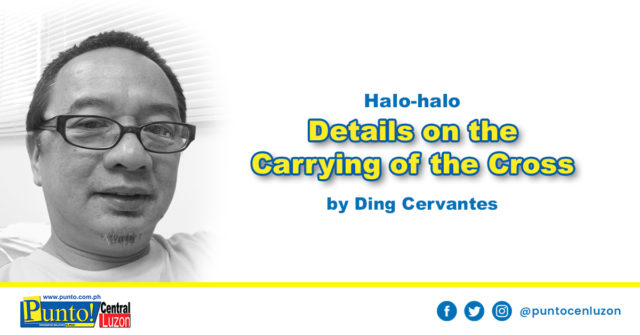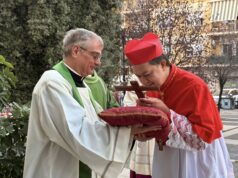MARIA VALTORTA (1897-1961) is nonpareil evangelical jewel of our times. She is now being pushed for sainthood not for reasons common. Hers was a life undoubtedly saintly, but more than anything else, her work (rather that of God through her) overshadows the intimacy and logic of her great predecessors, including those officially declared doctors of the Church. Why, I’d rather read her, enjoyably too, than Thomas Aquinas.
I had introduced Valtorta to some readers in the past. Now I cite her again, rather, her stupendous work initially titled Poem of Man-God that should enlighten anew this Holy Week. The book mixes her witnessing-by God’s power over timeless eternity- those biblical days, especially Jesus Christ’s life and death on earth, as well as comments on these by Jesus Himself.
The details of her witnessing, including the plants and locations she had described, have been confirmed, nay hailed, by experts as being credible, if not palpably accurate. Her account of events was in accord with history, and syncs with the gospel but with rich details that clarify and dissect.
As we face Holy Week, let me quote a portion of her account of Jesus’ carrying of the cross. Verbatim, it is as follows:
“The ascent to Calvary begins. A barren road, without the least shade, paved with uneven stones, that goes straight up the hill. Here again, when I used to read, I read that Calvary was a few metres high. It may be so. It is certainly not a mountain. But it is a hill, not certainly lower than the mount of the Crosses is, with respect to the Lungarni, where the Basilica of Saint Miniato is in Florence. Someone may say: « Oh! not much! » Yes, for one who is healthy and strong it is not much. But it is enough to have a weak heart to feel whether it is much or little!… I know that after I began to suffer from heart trouble, even if only in a mild form, I could no longer go up that hill without suffering a great deal and I was compelled to stop now and again, and I had no load on my shoulders. And I think that Jesus’ heart must have been in a very bad state after the flagellation and sweating blood… and I take only these two things into consideration.
“So Jesus suffers tremendously in climbing, also because of the weight of the cross which, being so long, must be very heavy. He finds a protruding stone and as He is exhausted, He can lift His feet only a little, so He stumbles and falls on His right knee, but He can hold Himself up with His left hand. The crowd howls with joy… He gets up again. He proceeds, bending and panting more and more, congested, feverish…
“The board that swings in front of Him obstructs His sight; His long tunic, the front part of which trails on the ground, as He now walks bending, hampers His steps. He stumbles again and falls on both knees, hurting Himself where He is already wounded; and the cross, which slips out of His hands and falls, after striking His back violently, compels Him to bend to pick it up and to toil painfully to put it back on His shoulder.
“While He does so, one can clearly see on His right shoulder the wound made by the rubbing of the cross, which has opened the many sores of the scourges, making them all into one, from which serum and blood transude, so that spot of His white tunic is all stained. The people even applaud for the joy of seeing Him fall so badly… Longinus urges to make haste and the soldiers, striking with the fl at of their daggers, press poor Jesus to proceed. He sets out again more and more slowly, despite all solicitations.
“Jesus seems completely intoxicated, as He sways so much, knocking against one or the other lines of soldiers, wandering all over the road. And the people notice it and shout: « His doctrine has gone to His head. Look, look, how He staggers! » And others, and they are not of the people, but priests and scribes, say with a grin: « No. It is still the fumes of the banquets in Lazarus’ house. Were they good? Take our food now » And other sentences of the kind.
“Longinus, who turns around now and again, feels sorry for Him and orders a few minutes’ stop. And the rabble insults him so much that the centurion orders the soldiers to charge them. And the fainthearted crowds at the sight of the shining threatening lances, run away shouting and hurling themselves here and there down the mountain.
“It is here that, among the few people who have remained, I again see the small group of the shepherds appear from behind some ruins, probably of a collapsed low wall. They are desolate, upset, dusty, in rags, and with the power of their glances they attract the Master’s attention. He turns His head round, He sees them… He looks at them fixedly as if they were the faces of angels, He seems to quench His thirst and fortify Himself with their tears, and He smiles… The order to resume the march is given and Jesus passes just in front of them and He hears their anguished weeping. With difficulty He turns His head round from under the yoke of the cross and He smiles once again… His solace… Ten faces… a rest in the burning sun…
And immediately afterwards, the pain of the third fall, a complete one. And this time He does not stumble. He falls because of a sudden lack of strength, due to a syncope. He falls headlong, knocking His face on the uneven stones, and He remains in the dust under the cross that falls on Him.
“The soldiers try to raise Him. But as He seems to be dead, they go and inform the centurion. While they go and come back, Jesus comes to Himself, and slowly, with the help of two soldiers, one of whom lifts the cross and the other helps the Condemned One to stand up, He puts Himself in His Place again. But He is really exhausted. « Make sure that He dies only on the cross! » shout the crowd. « If you let Him die beforehand, you will answer to the Proconsul, bear that in your minds. The culprit must arrive alive at the execution Place » say the chief scribes to the soldiers.
“The latter cast withering glances at them, but discipline prevents them from speaking. But Longinus is just as afraid as the Jews that the Christ may die on the road, and he does not want to have troubles. Without needing to be reminded, he knows what is his duty as officer responsible for the execution and he takes action. He takes action disconcerting the Jews who have already ran ahead along the road that they have reached from all over the mountain, sweating, scratching themselves to pass among the few thorny bushes of the bare burnt mountain, falling on the rubble encumbering it as if it were a dump for Jerusalem, without feeling any pain except that of missing the panting of the Martyr, one of His sorrowful glances, a gesture, even an involuntary one, of suffering, and with no other fear but that of not being successful in having a good place. So Longinus gives the order to take the longer road that winds up the mountain and is therefore not so steep.
“This road seems a path that by dint of being used by many people has changed into a rather comfortable road. This crossroad is situated about half-way up the mountain. But I see that farther up, the straight road is crossed four times by this one, which climbs with a slighter slope and to compensate for this is much longer. And many people are going up this road, but they do not participate in this shameful uproar of people possessed, who follow Jesus to take delight in His tortures. They are mostly women, weeping and veiled, and some small groups of men, very small ones indeed, who are much ahead of the women and are about to pass from sight, when going on their way, the road turns round the mountain.
“Calvary here looks somehow pointed in its odd structure, which is snout-shaped on one side, whilst on the other side it drops sheer. The men disappear behind the stony point and I lose sight of them.
“The people following Jesus are shouting with rage. It was more pleasant for them to see Him fall. While hurling obscene imprecations at the Condemned One and at those leading Him, some follow the judicial procession, and some go on almost running up the steep road, to make up for the disappointment received, by having a very good position on the top.”
(To be continued)





